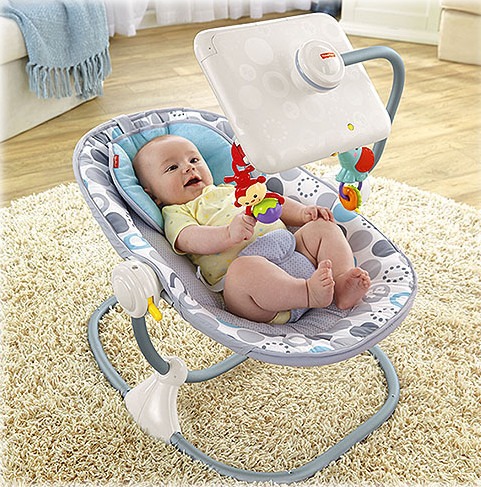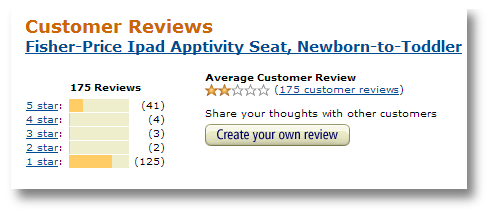Everywhere I turn I see babies, toddlers and young children with tablets/ipads and smartphones.
The glow of the brightly colored illuminated device is attractive and alluring for people of ANY age.
But, at what age is it appropriate?
Consider the following product from Fisher Price and the differing perspectives.
Share your thoughts in the comments section at the end.
The Newborn to Toddler APPtivity Seat
On the other side
Natali Morris in Mashable responds
Opinion
As a technology reporter and mommy blogger, you’d think the Fisher-Price Apptivity Seat for newborns — an infant seat with a holder for an iPad — would be something I appreciate. But I do not. Nor, it seems, do a number of advocacy groups that want it pulled off the market because they think iPads and babies are a dangerous combination.
Fisher-Price insists its seat is a sign of the times and age appropriate. I have done enough homework on early childhood development to tell you that not only is this seat a symptom of lazy parenting, it is guaranteed to make your baby more stupid.
It Takes Effort
Those of us who are parents know that raising children takes much more effort than we had originally planned, and this just doesn’t sit well with some people. Does the Fisher-Price Apptivity Seat promote laziness? I’m not sold on that. The kind of parent that overuses baby seats and hardly holds or interacts with their children may find that the Apptivity Seat supports their lifestyle. But if it wasn’t available, they’d just use the TV.
What’s more, research suggests it might be detrimental to a child’s development.
The Wrong Stimulation
Tablets give off blue light, which has been shown to disrupt sleep patterns. This isn’t ideal for newborns, who are supposed to sleep every 90 minutes, according to pediatrician Marc Weissbluth, author of Healthy Sleep Patterns, Happy Child. Naps promote healthy growth, so why would you want to disrupt them?
In Your Brain On Childhood, developmental psychologist Gabrielle Principe outlines the way that an infant’s brain develops. Screen time can actually delay that growth. She says babies learn through eye contact and interaction with the world. In fact, humans are the only primates with the whites of our eyes showing, Principe explains, which means we teach with our eyes. When we say the word “apple,” our babies know what we mean because they follow our pupils to that object.
When babies look at a screen, they’re not following their parents’ eyes and movements; instead, they are staring at something that does not interact with them. Sure, apps may try to engage babies, but they don’t have eyes or limbs. Babies can neither make eye contact with, nor imitate an avatar — no matter how cute. Most developers of children’s apps know this; that’s why most apps are written for children over 2, who are far too big for the Apptivity Seat.
Screen the Screen
The American Academy of Pediatrics recommends no screen time before babies are at least 2 years old. I admit that I did not abide by this rule, but I also avoided handing my children a tablet just to shut them up. I played carefully selected apps with them. I used the tablet as an interactive book — not as a babysitter. I made and still make efforts to limit screen time.
There will come a day when we have to tear electronics out of our kids’ hands. We will beg them to talk to us, look at us, interact with us. I am painfully aware of this. So why place them in front of screens almost from the moment they emerge from the womb?
In Brain Rules For Baby, brain scientist John Medina says there are two statistically significant ways to boost a child’s intellect: Talk to your baby, and nurse for up to a year. Not everyone can do those things, but do you want a tablet in your way while you try?
If you’re a lazy parent, you’ll come up with plenty of excuses to defend Fisher-Price’s $80 Apptivity Seat. But if you’ve done your homework, and read the research on early childhood and brain development, you’ll steer clear of it.
Source: http://mashable.com/2013/12/14/fisher-price-apptivity-seat/
Follow Natali Morris on Twitter @NataliMorris“Fisher-Price’s Apptivity Seat Is Bad for Babies” was a Trending Topic on Twitter this past December
Read the Reviews in Amazon
There are many passionate reviews of the product on Amazon. Click the image to read.
From the American Academy of Pediatrics
Media is everywhere. TV, Internet, computer and video games all vie for our children’s attention. Information on this page can help parents understand the impact media has in our children’s lives, while offering tips on managing time spent with various media. The AAP has recommendations for parents and pediatricians.
Today’s children are spending an average of seven hours a day on entertainment media, including televisions, computers, phones and other electronic devices. To help kids make wise media choices, parents should monitor their media diet. Parents can make use of established ratings systems for shows, movies and games to avoid inappropriate content, such as violence, explicit sexual content or glorified tobacco and alcohol use.
Studies have shown that excessive media use can lead to attention problems, school difficulties, sleep and eating disorders, and obesity. In addition, the Internet and cell phones can provide platforms for illicit and risky behaviors.
By limiting screen time and offering educational media and non-electronic formats such as books, newspapers and board games, and watching television with their children, parents can help guide their children’s media experience. Putting questionable content into context and teaching kids about advertising contributes to their media literacy.
The AAP recommends that parents establish “screen-free” zones at home by making sure there are no televisions, computers or video games in children’s bedrooms, and by turning off the TV during dinner. Children and teens should engage with entertainment media for no more than one or two hours per day, and that should be high-quality content. It is important for kids to spend time on outdoor play, reading, hobbies, and using their imaginations in free play.
Television and other entertainment media should be avoided for infants and children under age 2. A child’s brain develops rapidly during these first years, and young children learn best by interacting with people, not screens.
Source: http://www.aap.org/en-us/advocacy-and-policy/aap-health-initiatives/Pages/Media-and-Children.aspx



1 thought on “Babies and Mobile Devices. Where Are YOU on the issue?”
Comments are closed.